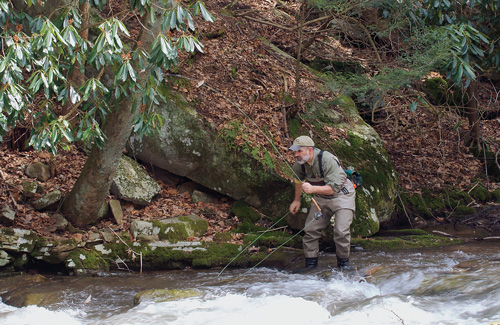I’m seated on a trunk of a pin oak that fell across the width of the stream. The run above it rushes along the edge of the far bank, a portion of which has collapsed around the exposed roots of the tree. For this small brook, the run is considered a long one. Sweeping around a pebbly shoal, where a colony of coltsfoot has taken hold, the current has gouged out the earth on the other side of the stream as it descends for at least twenty feet, forming a three-foot-by-two-foot pool against the trunk of the old tree.

The upper reaches of the little brook pass through shadows cast by a hemlock forest that even now, in this second week of April, remains pockmarked with snow. But here in its midsection, the long winter of snow and ice has receded, the sun sparkling on the stream’s surface, warm on the back of my neck.
The water this spring has been high with snowmelt and rain, but the fish remain active. Last week, casting a soft-hackle wet fly, I took a number of finger-length brookies from the stream’s headwaters, twisting and pulling the line, raising and lowering the rod, occasionally twitching the tip to impart action to the pattern.
Yesterday, I fooled a brown trout in the big pool under the waterfall that pours out of the shale ravine that comprises the brook’s lower section. Having discovered a few black stoneflies in the bushes, I tied on an imitation with a cdc wing and skittered it across the pool. A brook trout, no more than six inches long, slashed at the surface, with another, an inch or two longer, doing the same a few minutes later. The brown rose on my next cast, a wild fish measuring thirteen inches, with pumpkin-colored spots along its side.
This afternoon, I turned off the macadam road that crosses over the little stream and parked in the lot beside the ranger’s station. Walking into the meadow that lies between these two distinct sections of brook, I began casting the same stonefly pattern, until noticing a dun-colored mayfly fluttering above the water. Too small to be imitated by a Hendrickson pattern, I first thought of tying on a Quill Gordon, but decided upon a Blue Quill emerger. Not much longer than my pinkie, a brook trout grabbed the fly on my first cast, and in a little riffle just below the fallen oak, I fooled a second that fit nicely in my palm.
I know the fish that calls the run above the tree its home, a ten-inch rainbow that has grown cautious over the last few years.
I pricked the rainbow a few springs back when the fish rose in the pool beside the old oak’s roots. The fat trout snapped at a dry fly tied with a body comprised of a few strands of pheasant tail and a wing of brown rooster hackle tied parachute style using a clump of white calf’s tail for a post. Setting the hook too soon, I only nicked its jaw.
The following summer, I cast an imitation of a black ant across the surface, watching the big bushy pattern bounce along the cu rrent along the edge of the undercut bank and into the pool at the bottom of the run. Surprised that I was unable to raise the trout, I repeated the maneuver, but without success. Before leaving, I cast the ant beside the shoal where the yellow flowers of the coltsfoot now bloom, the current carrying it across the head of the run, where the rainbow swirled, a sudden flash of crimson, the fly wobbling in the fish’s wake.
With the Blue Quill pattern tied to my tippet, I stare into the water above me, searching for a rise, the white of maw or flutter of fin, some indication of the whereabouts of the rainbow. Anyone familiar with big-river fishing knows that the key is to break down what at first glance appears to be a huge expanse of water into its smaller parts in order to discover where the fish are holding. What they may not know is that the same holds true when fishing a small stream.
Might my trout be waiting in the pool at the end of the run, or at its head across from the shoal, or along the run itself, either under the bank or in the current, or perhaps on the near side in shallow water? While hoping for sudden inspiration or divine intervention, anything to help me decide where to place my fly, I wait; but the trout does not give up its location. Holding fast to a branch on my side of the brook, a crow caws its disapproval, head bobbing up and down, as if to say, “get on with it already.” When I look up, the big bird cocks its head to one side, black eye staring down at me before flying off across the meadow.
On one knee, I swing the line over my shoulder and then snap it forward. For a moment the imitation of the dun-colored mayfly hangs in the air. Hidden by the rushing current, a rainbow trout turns toward the tiny pattern of feather and wool that flutters down upon the sun-streaked surface.